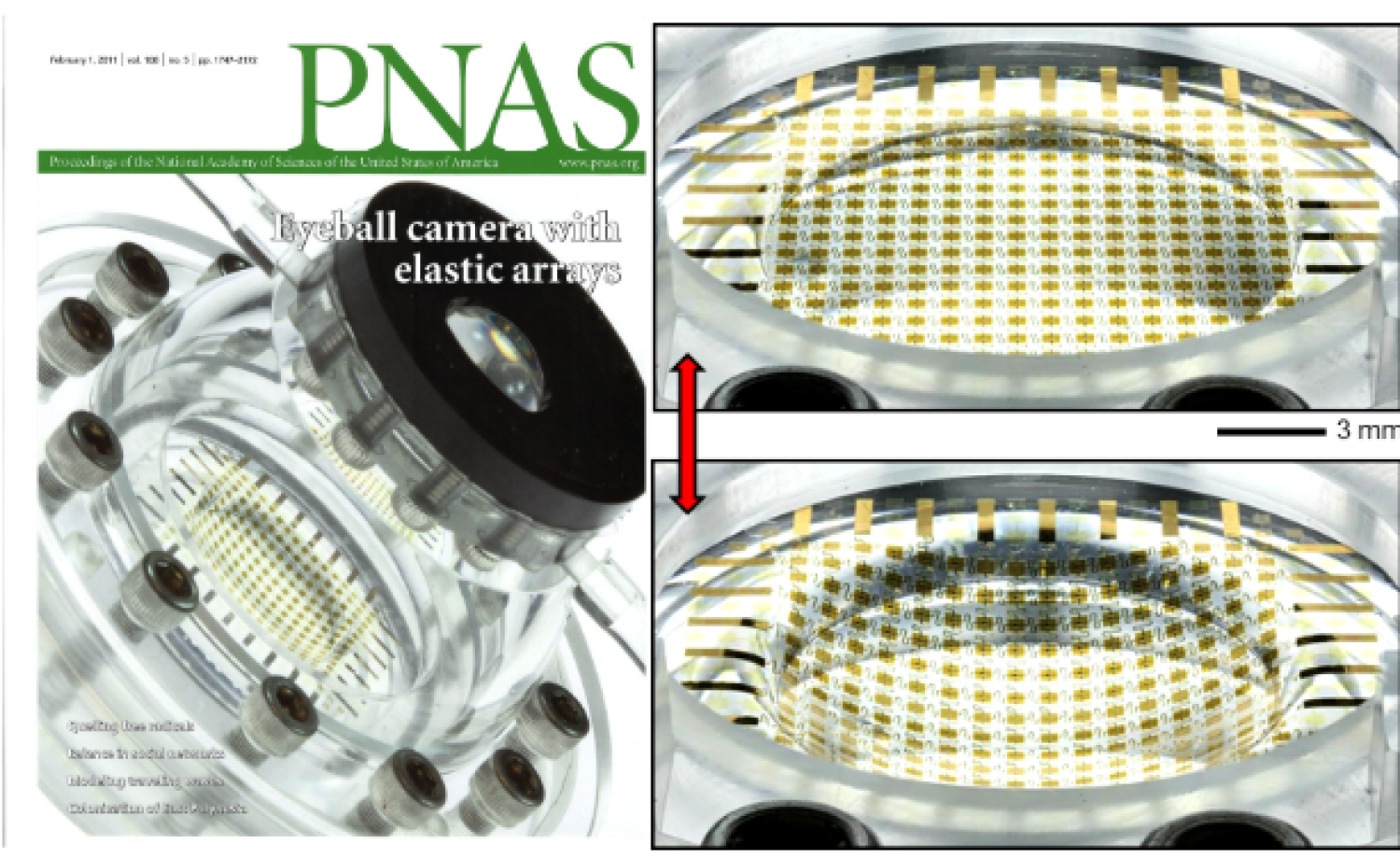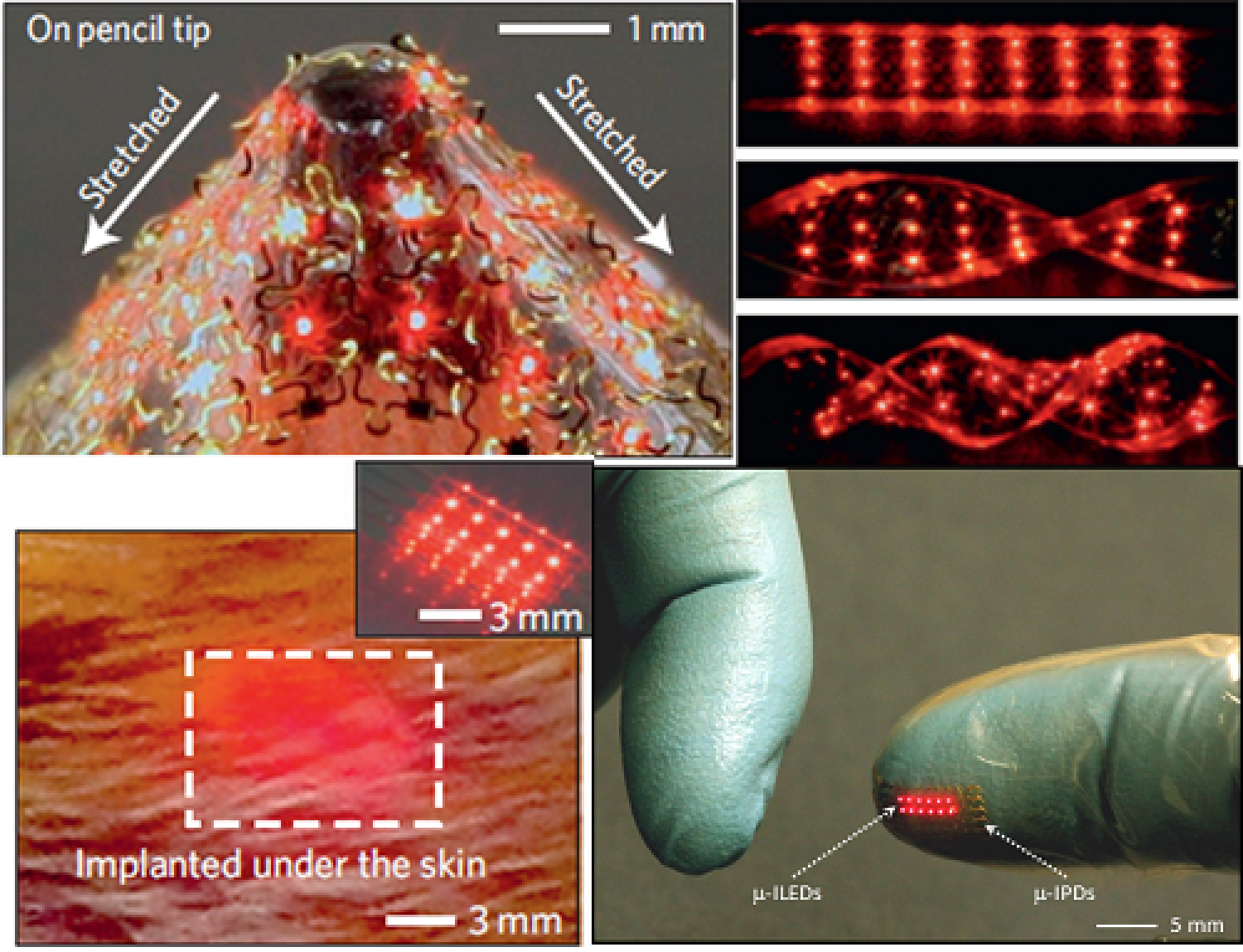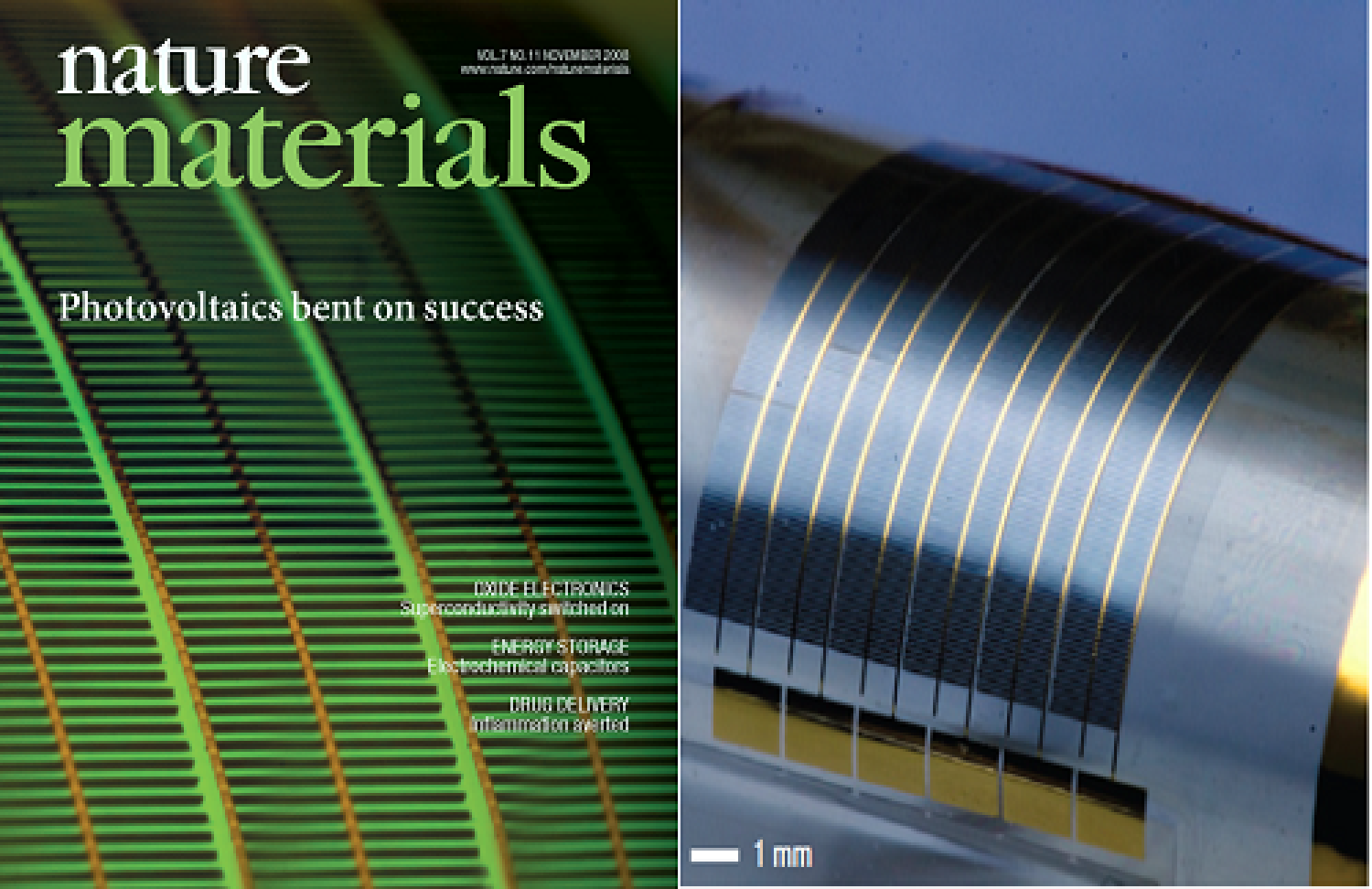Stretchable Electronics: Devices, Materials, and Mechanics
Stretchable electronics combines the electronic performance of conventional wafer-based semiconductor devices and mechanical properties of a rubber band, and thus can have very broad applications that are impossible for hard, planar integrated circuits that exist today. Examples range from surgical and diagnostic implements that integrate with the human body to provide advanced therapeutic capabilities, to structural health monitors and inspection systems for civil engineering. In this research thrust, we develop materials and devices for stretchable electronics, we also study fundamental mechanics to further our understanding of the underlying physics and to guide the design and opimization.
Bio-inspired Bug Eye Cameras (Artificial Compound Eye)

References:
- Y. M. Song+, Y. Xie+, V. Malyarchuk+, J. Xiao+, I. Jung, K.-J. Choi, Z. Liu, H. Park, C. Lu, R.-H. Kim, R. Li, K. B. Crozier, Y. Huang, and J. A. Rogers, Digital Cameras With Designs Inspired By the Arthropod Eye, Nature 497, 95–99 (2013)
Highlighted on the cover of Nature Magazine.
Tunable Eyeball Cameras With Zoom

References:
I. Jung, J. Xiao, V. Malyarchuk, C. Lu, M. Li, Z. Liu, J. Yoon, Y. Huang, and J. A. Rogers, Dynamically tunable hemispherical electronic eye camera system with adjustable zoom capability, Proc. Natl. Acad. Sci. USA 108, 1788-1793 (2011) (featured on the cover of PNS magazine)
C. Lü, M. Li, J. Xiao*, I. Jung, J. Wu, Y. Huang, K.-C. Hwang, and J.A. Rogers, Mechanics of tunable hemispherical electronic eye camera systems that combine rigid device elements with soft elastomers, Journal of Applied Mechanics-Transactions of the ASME (accepted)
- S. Wang, J. Xiao, J. Song, H. C. Ko, K.-C. Hwang, Y. Huang, and J. A. Rogers, Mechanics of curvilinear electronics, Soft Matter 6, 5757–5763 (2010)
- D.-H. Kim, J. Xiao, J. Song, Y. Huang and J. A. Rogers, Stretchable, Curvilinear Electronics Based On Inorganic Materials, Advanced Materials 22, 2108–2124 (2010)
- S. Wang, J. Xiao, I. Jung, J. Song, H. C. Ko, M. P. Stoykovich, Y. Huang, K.-C. Hwang and J. A. Rogers, Mechanics of Hemispherical Electronics, Appl. Phys. Lett. 95, 181912 (2009).
- J. Song, Y. Huang, J. Xiao, S. Wang, K.C. Hwang, H.C. Ko, D.H. Kim, M.P. Stoykovich, and J.A. Rogers, Mechanics of noncoplanar mesh design for stretchable electronic circuits, Journal of Applied Physics 105, 123516 (2009).
- H. C. Ko, M. P. Stoykovich, J. Song, V. Malyarchuk, W. M. Choi, C.-J. Yu, J. B. Geddes, J. Xiao, S. Wang, Y. Huang, and J. A. Rogers, A Hemispherical Electronic Eye Camera Based on Compressible Silicon Optoelectronics. Nature 454, 748-753 (2008). (featured on the cover of nature magazine)
Flexible, Ultrathin Sensors for Biomedical Applications

References:
Viventi et al., Flexible, Foldable, Actively Multiplexed, High-Density Electrode Array for Mapping Brain Activity in vivo, Nature Neuroscience 14, 1599–1605 (2011)
Kim et al., Dissolvable Films of Silk Fibroin for Ultrathin Conformal Bio-Integrated Electronics, Nature Materials 9, 511-517 (2010) (featured on the cover of Neural Sensors)
- Viventi et al., A Conformal, Bio-interfaced Class of Silicon Electronics for Mapping Cardiac Electrophysiology, Science Translational Medicine 2, 24ra22 (2010). (featured on the cover of Science Translational Medicine)
Stretchable Inorganic LEDs

References:
- R.-H. Kim, D.-H. Kim, J. Xiao, B. H. Kim, S.-I. Park, B. Panilaitis, R. Ghaffari, J. Yao, M. Li, Z. Liu, V. Malyarchuk, D. G. Kim, A.-P. Le, R. G. Nuzzo, D. L. Kaplan, F. G. Omenetto, Y. Huang, Z. Kang, and J. A. Rogers, Waterproof AlInGaP optoelectronics on stretchable substrates with applications in biomedicine and robotics, Nature Materials 9, 929-937 (2010)
Flexible Solar Cells

References:
- Baca et al., Compact monocrystalline silicon solar modules with high voltage outputs and mechanically flexible designs, Energy & Environmental Science 3, 208-211 (2010) (featured on the cover of Solar EES)
- Yoon et al., Ultrathin silicon solar microcells for semitransparent, mechanically flexible and microconcentrator module designs. Nat. Mater. 7, 907-915 (2008). (featured on the cover of Nature Materials)
Stretchable and Compressible Conductors

References:
Xiao et al., Stretchable and Compressible Thin Films of Stiff Materials on Compliant Wavy Substrates. Appl. Phys. Lett. 93, 013109 (2008)
Xiao et al., Analytical and Experimental Studies of the Mechanics of Deformation in a Solid with a Wavy Surface Profile. Journal of Applied Mechanics-Transactions of the ASME 77, 011003 (2010).

